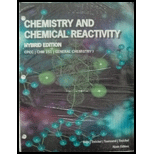
CHEMISTRY+CHEM...HYBRID ED.(LL)>CUSTOM<
9th Edition
ISBN: 9781305020788
Author: John C.Kotz, Paul M. Treichel, John Townsend, David Treichel
Publisher: CENGAGE C
expand_more
expand_more
format_list_bulleted
Concept explainers
Question
Chapter 20, Problem 36GQ
Interpretation Introduction
Interpretation: The equilibrium constant for the reaction
Concept introduction:
Equilibrium constant in terms of concentration
Equilibrium constant and Gibbs free energy:
Relation between Gibbs free energy , Enthalpy and Entropy:
Expert Solution & Answer
Trending nowThis is a popular solution!

Students have asked these similar questions
Can I get help on drawing my arrows
Can I get helpp drawing my arrows
Which of the m/z values corresponds to the base peak in the mass spectrum shown?
100
80
A. 45
B. 44
C. 29
D. 15
Intensity
20
0
10 20
30 40
B-
m/z
-8
50
E. 30
Which of the m/z values correspond to the molecular ion for the compound shown?
A. 18
B. 82
OH
C. 100
D. 102
E. 103
Chapter 20 Solutions
CHEMISTRY+CHEM...HYBRID ED.(LL)>CUSTOM<
Ch. 20.1 - Prob. 1RCCh. 20.1 - Prob. 2RCCh. 20.2 - Prob. 1RCCh. 20.2 - Prob. 2RCCh. 20.3 - Prob. 1RCCh. 20.3 - Prob. 2RCCh. 20.3 - Prob. 3RCCh. 20.4 - Prob. 1RCCh. 20.4 - Prob. 2RCCh. 20.4 - 3. Which of the following is a renewable energy...
Ch. 20.5 - Prob. 1RCCh. 20.5 - Prob. 2RCCh. 20.6 - Prob. 1QCh. 20.6 - Prob. 1RCCh. 20.7 - Prob. 1QCh. 20.7 - Prob. 2QCh. 20 - In the discussion on the composition of air,...Ch. 20 - Prob. 2PSCh. 20 - Prob. 3PSCh. 20 - Dinitrogen monoxide, N2O (commonly called nitrous...Ch. 20 - Prob. 5PSCh. 20 - Prob. 6PSCh. 20 - Prob. 9PSCh. 20 - Although there are a number of...Ch. 20 - Prob. 12PSCh. 20 - Prob. 13PSCh. 20 - Prob. 14PSCh. 20 - Prob. 15PSCh. 20 - Prob. 17PSCh. 20 - The enthalpy of combustion of isooctane (C8H18),...Ch. 20 - Energy consumption in the United States amounts to...Ch. 20 - Prob. 20PSCh. 20 - Prob. 23PSCh. 20 - Prob. 25PSCh. 20 - Prob. 28PSCh. 20 - In methane hydrate the methane molecule is trapped...Ch. 20 - Prob. 30PSCh. 20 - Prob. 31PSCh. 20 - Prob. 32PSCh. 20 - Prob. 33PSCh. 20 - Prob. 34PSCh. 20 - Prob. 35GQCh. 20 - Prob. 36GQCh. 20 - Prob. 37GQCh. 20 - Prob. 38GQCh. 20 - Prob. 40GQCh. 20 - Prob. 41ILCh. 20 - Prob. 42ILCh. 20 - Define the terms renewable and nonrenewable as...Ch. 20 - Prob. 44SCQCh. 20 - Prob. 45SCQCh. 20 - Prob. 46SCQCh. 20 - Prob. 47SCQCh. 20 - What is the likelihood that hydrogen (H2) will...Ch. 20 - Prob. 49SCQCh. 20 - Which sulfur compounds are atmospheric pollutants?...
Knowledge Booster
Learn more about
Need a deep-dive on the concept behind this application? Look no further. Learn more about this topic, chemistry and related others by exploring similar questions and additional content below.Similar questions
- Please explain how to calculate the pH.arrow_forwardI'm having trouble with converting lewis diagrams into VSEPR diagrams. I currently have this example of C2BrCl3 which I want to turn into a lewis structure, but I'm not sure what steps I need to do in order to do so. I have the table written down, however, there's two central atoms so what would I do? There seems to be 4 electron domains on the carbon atom and no lone pairs so it would seem like this shape would be tetrahedral. Here's what I have now. Thanks!arrow_forwardWe discussed the solid phase resin using in peptide synthesis. Provide a mechanism, for its formation. DRAW THE MECHANISM.arrow_forward
- (a) 21.8 Name the following compounds. & (b) Br (e) O₂N. (h) H (c) Br (d) NH2 ☑N Br H ہیں Ph (g) OMe бл .0-0.e 21.9 Draw a structural formula for each compound. (a) 2,3-Dinitrotoluene (c) Diphenylmethanol (e) p-Nitroaniline (b) 3-Propylanisole (d) m-Propylphenol (f) Pentabromobenzenearrow_forwardIs this the major product of this reaction?arrow_forwardPlease helparrow_forward
arrow_back_ios
SEE MORE QUESTIONS
arrow_forward_ios
Recommended textbooks for you
 Chemistry: The Molecular ScienceChemistryISBN:9781285199047Author:John W. Moore, Conrad L. StanitskiPublisher:Cengage Learning
Chemistry: The Molecular ScienceChemistryISBN:9781285199047Author:John W. Moore, Conrad L. StanitskiPublisher:Cengage Learning ChemistryChemistryISBN:9781305957404Author:Steven S. Zumdahl, Susan A. Zumdahl, Donald J. DeCostePublisher:Cengage Learning
ChemistryChemistryISBN:9781305957404Author:Steven S. Zumdahl, Susan A. Zumdahl, Donald J. DeCostePublisher:Cengage Learning Chemistry: An Atoms First ApproachChemistryISBN:9781305079243Author:Steven S. Zumdahl, Susan A. ZumdahlPublisher:Cengage Learning
Chemistry: An Atoms First ApproachChemistryISBN:9781305079243Author:Steven S. Zumdahl, Susan A. ZumdahlPublisher:Cengage Learning Principles of Modern ChemistryChemistryISBN:9781305079113Author:David W. Oxtoby, H. Pat Gillis, Laurie J. ButlerPublisher:Cengage Learning
Principles of Modern ChemistryChemistryISBN:9781305079113Author:David W. Oxtoby, H. Pat Gillis, Laurie J. ButlerPublisher:Cengage Learning Chemistry: Principles and ReactionsChemistryISBN:9781305079373Author:William L. Masterton, Cecile N. HurleyPublisher:Cengage Learning
Chemistry: Principles and ReactionsChemistryISBN:9781305079373Author:William L. Masterton, Cecile N. HurleyPublisher:Cengage Learning

Chemistry: The Molecular Science
Chemistry
ISBN:9781285199047
Author:John W. Moore, Conrad L. Stanitski
Publisher:Cengage Learning

Chemistry
Chemistry
ISBN:9781305957404
Author:Steven S. Zumdahl, Susan A. Zumdahl, Donald J. DeCoste
Publisher:Cengage Learning

Chemistry: An Atoms First Approach
Chemistry
ISBN:9781305079243
Author:Steven S. Zumdahl, Susan A. Zumdahl
Publisher:Cengage Learning

Principles of Modern Chemistry
Chemistry
ISBN:9781305079113
Author:David W. Oxtoby, H. Pat Gillis, Laurie J. Butler
Publisher:Cengage Learning

Chemistry: Principles and Reactions
Chemistry
ISBN:9781305079373
Author:William L. Masterton, Cecile N. Hurley
Publisher:Cengage Learning

Calorimetry Concept, Examples and Thermochemistry | How to Pass Chemistry; Author: Melissa Maribel;https://www.youtube.com/watch?v=nSh29lUGj00;License: Standard YouTube License, CC-BY